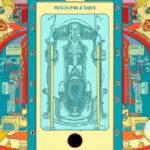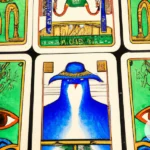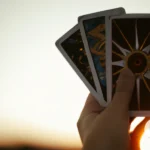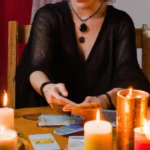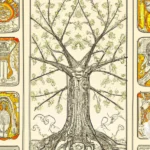Tarot cards have been used for divination and fortune-telling for centuries. However, few people know about the influence of Carl Jung on the interpretation of these ancient cards. Carl Jung, a Swiss psychologist and psychoanalyst, developed the theory of analytical psychology, which emphasizes the importance of understanding the unconscious mind. His work has had a significant impact on fields such as dream analysis and personality psychology. But how did Jung become interested in tarot cards, and what is the relationship between his ideas and the interpretation of these enigmatic cards? In this article, we will explore the life and work of Carl Jung and examine how his ideas have influenced tarot card readings.
Who was Carl Jung?
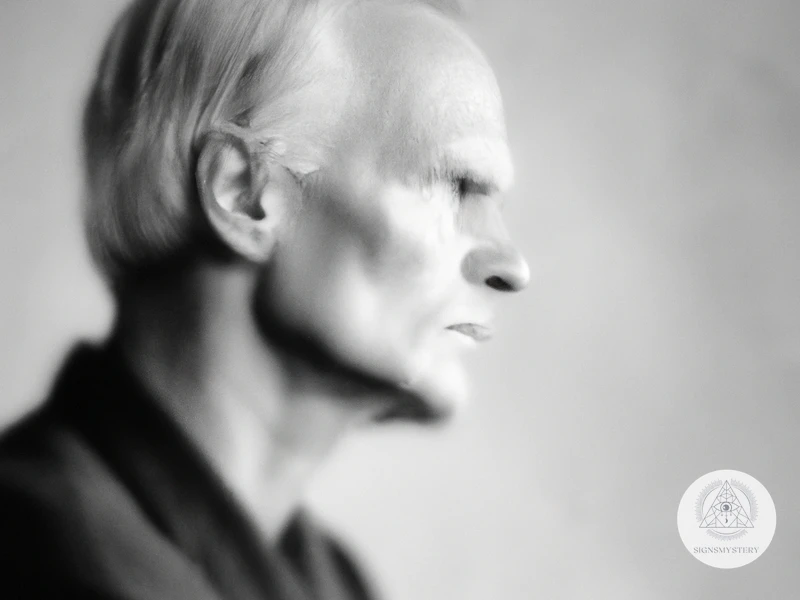
The world of psychology owes a great deal to Carl Jung – the Swiss psychiatrist, psychoanalyst, and founder of analytical psychology. His influence reaches far and wide, and his ideas and theories continue to intrigue and inspire people to this day. Jung’s work has had a significant impact on our understanding of the collective unconscious, archetypes, and various psychological types. His ideas have also had a profound effect on the world of tarot card readings, leading to the development of Jungian Tarot interpretation. In this section, we’ll explore the life and contributions of Carl Jung and examine the intriguing relationship between his ideas and the world of tarot. To learn more about the tarot and its relationship to Jungian psychology, check out tarot archetypes and Jungian psychology.
The Life of Carl Jung
Carl Gustav Jung was a Swiss psychiatrist and psychoanalyst who was born in Kesswil, Switzerland in 1875. He was the son of a Protestant clergyman and grew up in a rural town near Basel. Jung had an interest in science from a young age, and began studying medicine at the University of Basel when he was 19 years old.
Jung’s early career
After completing his medical degree, Jung worked at a mental hospital in Zurich where he became interested in the field of psychiatry. He also began studying under Sigmund Freud, the founder of psychoanalysis, who at the time was becoming well known for his theories about the human mind. Jung was initially drawn to Freud’s work, and the two men formed a close relationship. They corresponded regularly, and Jung even served as the president of Freud’s psychoanalytic association.
Jung’s break from Freud
However, Jung began to have disagreements with Freud over their differing ideas about human psychology. While Freud focused on the role of childhood experiences and sexual impulses in shaping people’s personalities, Jung believed that there was more to the human mind than just these factors. He became interested in the idea of the collective unconscious, which he believed was a repository of shared experiences and memories that all people have access to.
Jung’s later work
Jung went on to develop his own theories about psychology, which he called analytical psychology. He believed that people could achieve greater self-awareness by exploring their own unconscious minds, and he developed a number of techniques for doing so. He also wrote extensively about his ideas, and published numerous books and articles throughout his life.
Legacy
Today, Jung is remembered as one of the most influential figures in the field of psychology. His ideas about the importance of the unconscious mind, the collective unconscious, and the process of individuation have had a lasting impact on the way that we think about ourselves and our mental health. Jung’s ideas have also influenced other fields, such as art, literature, and spirituality.
Source: Tarot and Jungian Interpretation
Carl Jung’s Work and Contributions
Carl Jung was a prominent Swiss psychiatrist and psychoanalyst, who contributed extensively to the field of psychology in the 20th century. Jung’s work and ideas have had a significant influence on modern psychology, spirituality, and popular culture. Here are some of Jung’s main contributions:
- Archetypes: Jung introduced the concept of archetypes, which are universal, symbolic patterns or images that exist in the collective unconscious. These patterns are often seen in myths, fairy tales, and dreams, and can be interpreted as representations of aspects of the human psyche.
- The Shadow: Jung also developed the idea of the “shadow,” which refers to the darker, more hidden aspects of an individual’s personality. The shadow can include repressed desires, fears, and traits that a person may not want to acknowledge or accept. Jung believed that acknowledging and integrating the shadow was crucial for self-discovery and growth.
- Analytical Psychology: Jung founded the school of analytical psychology, which emphasizes the importance of the unconscious mind and the role of symbolism and mythology in understanding the human psyche. Analytical psychology also encourages personal exploration and self-awareness as a means of achieving wholeness and balance.
- The Collective Unconscious: Jung proposed the existence of a collective unconscious, which is a shared reservoir of unconscious knowledge and experiences that humans inherit from their ancestors. This concept suggests that certain archetypes and symbols are universally understood across cultures and time periods.
Jung’s work has had a significant impact on the study of tarot cards. His ideas about archetypes and the collective unconscious have been particularly relevant to tarot card interpretation. Tarot readers who use a Jungian approach often see the cards as expressions of psychological themes and patterns. They use the cards to explore the unconscious mind and to gain insight into the psyche. To learn more about how Jungian psychology relates to tarot, see “The Tarot and the Collective Unconscious”, “Tarot and Self-Discovery: A Jungian Approach”, “The Shadow Self in Tarot: A Jungian Perspective”, and “Numerology, Tarot, and Jungian Psychology”.
The Relationship between Carl Jung and Tarot Cards
When it comes to tarot card readings, many people may not realize the significant influence that Carl Jung had on the development and interpretation of tarot. As a renowned Swiss psychiatrist and psychoanalyst, Jung’s theories and concepts on the collective unconscious, archetypes, and psychological types helped to shape the way in which tarot cards are understood and read today. In this section, we will explore the relationship between Carl Jung and tarot cards, delving into why he began to study them and how his ideas have influenced tarot card readings. We will also discuss how to use tarot cards with a Jungian perspective, providing a Jungian tarot card reading example to illustrate the application of his ideas. For those interested in using tarot cards as a tool for self-discovery through a Jungian lens, this section provides an essential foundation.
Why did Carl Jung begin to study Tarot?
Carl Jung, a Swiss psychiatrist and psychoanalyst, began to study Tarot cards during his middle age. His interest in Tarot emerged from his fascination with symbols and the human psyche. Tarot cards, as he saw them, were a tool for unlocking the subconscious mind and accessing hidden truths about human behavior.
Jung believed that Tarot cards could be used as a means of self-discovery and personal growth. He saw them as a way of tapping into the collective unconscious, a shared pool of ancestral memories and experiences that lie beneath the surface of human awareness.
Jung was particularly intrigued by the Major Arcana cards, seeing them as a reflection of the archetypes that exist within the human psyche. He believed that by studying the symbolic imagery of the Major Arcana, one could gain insight into the universal patterns of human behavior and the underlying motivations that drive us.
Jung also recognized the potential of Tarot as a tool for therapy. He used Tarot cards to help his patients explore their unconscious thoughts and feelings, working with the images on the cards to gain a deeper understanding of their psyches.
All of these factors contributed to Jung’s decision to study Tarot. To him, the cards were a powerful tool for unlocking the mysteries of the human mind and exploring the depths of the psyche. To this day, Tarot remains a popular medium for self-discovery and personal growth, heavily influenced by Jung’s ideas and teachings. For those interested in using Tarot with a Jungian perspective for self-discovery, /tarot-self-discovery-jungian/ can be a great resource.
How did Carl Jung’s ideas influence Tarot Card Readings?
Carl Jung’s innovative ideas have positively influenced the world of Tarot Card readings. Some significant ways in which Jung influenced Tarot Card readings are:
| Jung’s Concept | How it Influenced Tarot |
|---|---|
| Collective Unconsciousness | Carl Jung believed in a collective unconsciousness, which refers to the deep-rooted, shared experiences and emotions of all humans across time and cultures. This concept has transformed the way Tarot Card readers approach their work, encouraging them to tap into this collective unconsciousness to gain deeper insights into their readings. |
| Symbolism | Jung’s emphasis on symbolism and the power it has to evoke deep, unconscious emotions has had a positive impact on Tarot Card readings. Jung believed in the transformative ability of symbols, and this has encouraged tarot card readers to look beyond the surface level meaning of Tarot cards, instead, seeking to tap into the hidden meaning behind the images presented in each card. |
| Archetypes and inner self | Jung’s exploration of archetypes has played a significant role in how Tarot Card readers understand the Major Arcana cards. Each Major Arcana card represents a universal archetype that can be seen across cultures and time. Tarot Card readers can use these Archetypes presented within the cards as a tool to help their clients explore their inner selves, revealing the hidden forces that motivate and drive their lives. |
| Psychological Types | Jung’s Theory of Psychological types has shifted the way Tarot Card Readers view the Minor Arcana Cards. By categorizing people into different psychological types, Jung has provided a framework for understanding the different personalities that exist within a tarot card reading. This helps Tarot Card Readers focus on key aspects of their clients, helping them to provide more thoughtful and tailored insights and guidance. |
Carl Jung’s influence has played a substantial role in the development of Tarot Card readings. By emphasizing the importance of symbolism, archetypes, and psychological types, Tarot Card Readers can provide deeper insights, understanding, and guidance to their clients.
Major Arcana Cards and Carl Jung’s Archetypes
The Major Arcana cards in a Tarot deck represent significant life events and archetypes. These archetypes, according to Carl Jung, are universal symbols or patterns that exist in the collective unconscious of humanity. Jung believed that these archetypes are reflected in all cultures, religions, and myths, and they represent the fundamental elements of the human psyche.
The Fool card, for example, represents the archetype of the Explorer or the Adventurer. This archetype embodies the idea of taking risks, exploring new territories, and trying new experiences. The Magician card represents the archetype of the Magician or the Trickster, who is a master of illusion, transformation, and manifestation.
The High Priestess card represents the archetype of the Wise Woman or the Mystic, who is a keeper of secrets, mysteries, and hidden knowledge. The Empress card represents the archetype of the Mother or the Nurturer, who is a symbol of fertility, growth, and abundance.
The Emperor card represents the archetype of the Father or the Authority, who is a symbol of power, order, and discipline. The Hierophant card represents the archetype of the Priest or the Teacher, who is a symbol of tradition, religion, and spirituality. The Lovers card represents the archetype of the Lovers or the Union, which embodies the idea of love, connection, and harmony.
The Chariot card represents the archetype of the Champion or the Conqueror, who is a symbol of victory, ambition, and success. The Strength card represents the archetype of the Strong Woman or the Survivor, who is a symbol of inner strength, courage, and resilience.
The Hermit card represents the archetype of the Hermit or the Meditator, who is a symbol of introspection, seclusion, and wisdom. The Wheel of Fortune card represents the archetype of the Cyclical Nature of Life, which embodies the idea of change, transformation, and destiny.
The Justice card represents the archetype of the Judge or the Mediator, who is a symbol of fairness, balance, and objectivity. The Hanged Man card represents the archetype of the Sacrifice or the Martyr, who is a symbol of letting go, surrender, and acceptance.
The Death card represents the archetype of Transformation or Change, which embodies the idea of endings, transformation, and rebirth. The Devil card represents the archetype of the Shadow Self or the Temptation, which is a symbol of the dark aspects of human nature.
The Tower card represents the archetype of the Upheaval or the Awakening, which is a symbol of sudden change, crisis, and revelation. Finally, the Star card represents the archetype of the Visionary or the Hope, which embodies the idea of inspiration, transcendence, and optimism.
Minor Arcana Cards and Carl Jung’s Psychological Types
The Minor Arcana is the set of tarot cards that represents the day-to-day experiences of life. It is divided into four suits, each with 14 cards: Ace to Ten, and four court cards – Page, Knight, Queen, and King. Carl Jung’s theories of psychological types can be applied to the Minor Arcana cards, allowing for a deeper understanding of their meanings and interpretations.
1. Wands
Wands represent the element of fire, which is associated with intuition, creativity, and passion. Jung’s psychological types theory includes the concept of intuition, which he defined as the ability to perceive
Subscribe to Our Newsletter
Sign up to receive the latest news and updates.
2. Cups
Cups represent the element of water, which is associated with emotions, relationships, and spirituality. Jung’s psychological types theory includes the concept of feeling, which he defined as the ability to make decisions based on subjective values and emotions. This aligns with the qualities of the Cups suit. The court cards of this suit may represent the different levels of feeling: the Page as a beginner in emotional awareness, the Knight as an emotional adventurer, the Queen as an emotionally nurturing figure, and the King as a master of emotional intelligence.
3. Swords
Swords represent the element of air, which is associated with logic, intellect, and communication. Jung’s psychological types theory includes the concept of thinking, which he defined as the ability to make decisions based on objective analysis and rational thought. This aligns with the qualities of the Swords suit. The court cards of this suit may represent the different levels of thinking: the Page as a beginner in rational thought, the Knight as a logical adventurer, the Queen as a rational thinker with emotional intelligence, and the King as a master of rational thought and communication.
4. Pentacles
Pentacles represent the element of earth, which is associated with the physical world, material possessions, and practicality. Jung’s psychological types theory includes the concept of sensation, which he defined as the ability to perceive information through the senses and the physical world. This aligns with the qualities of the Pentacles suit. The court cards of this suit may represent the different levels of sensation: the Page as a beginner in practical matters, the Knight as a physical adventurer, the Queen as a practical and nurturing figure, and the King as a master of practicality and material success.
By applying Jung’s psychological types to the Minor Arcana cards, tarot readers can gain a deeper understanding of the cards and the messages they convey. Understanding the psychological underpinnings of the cards also allows for more personalized interpretations and a greater connection with the querant.
Using Tarot Cards with a Jungian Perspective
When it comes to tarot card readings, one approach is to use them with a Jungian perspective. This means incorporating the ideas and concepts put forth by famous psychologist Carl Jung. By doing so, tarot readings can become even more insightful and illuminating. In this section, we will explore how to apply Jung’s ideas in tarot readings, as well as provide a practical example of a Jungian tarot card reading. Let’s delve into the fascinating world of tarot readings with a Jungian twist.
How to Apply Carl Jung’s Ideas in Tarot Card Readings
One of the most valuable aspects of Carl Jung’s ideas is that they can be applied to nearly any field, including tarot card readings. Here are some ways you can use Jung’s concepts to enhance your tarot readings:
| Jung’s Concept | Application in Tarot Readings |
|---|---|
| The collective unconscious | Recognize that the archetypes and symbols in the tarot are expressions of the collective unconscious, and use this knowledge to bring deeper meaning to your interpretations. |
| Archetypes | Pay attention to the archetype represented by the cards that come up in your readings. Consider both the traditional meanings of the card and the personal associations the client may have with the archetype. |
| Shadow self | Recognize that the darker or more challenging cards in the deck often represent aspects of the client’s shadow self. Use this awareness to gently explore those areas they may be avoiding or repressing. |
| Individuation | Encourage the client to see their tarot readings as part of their journey towards individuation, or self-realization. Help them see how the cards reflect different aspects of their personality and can aid in their growth and development. |
| Psychological types | Use Jung’s concepts of extroversion/introversion, thinking/feeling, sensing/intuition, and judging/perceiving to help the client understand themselves better and make choices that align with their true nature. |
By incorporating Carl Jung’s ideas into your tarot readings, you can help clients gain a deeper understanding of themselves and their lives. Keep in mind that these concepts are just tools, however, and it’s important to stay open to whatever messages the cards may have for each unique individual.
A Jungian Tarot Card Reading Example
To demonstrate how Carl Jung’s ideas can be applied in a Tarot card reading, let’s take a look at a sample reading using a Jungian perspective.
The Question: What should I focus on in order to achieve greater personal growth and fulfillment?
The Spread: We will use a three card spread representing the past, present, and future.
| Past | Present | Future |
|---|---|---|
| The Tower | The Fool | The World |
Interpretation:
–The Tower: This card represents a sudden upheaval or disruption in the querent’s past. This event may have been traumatic and caused a significant shift in their life. However, the presence of this card also suggests an opportunity for growth and transformation through the experience.
–The Fool: In the present, the querent is being asked to embrace a sense of childlike wonder and take a leap of faith into the unknown. The Fool represents a willingness to take risks and trust in the journey despite not knowing the outcome.
–The World: The placement of this card in the future position suggests that the querent will experience a sense of completion and wholeness in their life. They will likely achieve a significant goal or reach a state of heightened awareness and understanding.
This reading suggests that the querent may need to confront past trauma and embrace a new sense of adventure in order to achieve their ultimate goal of personal growth and fulfillment. Through the use of Carl Jung’s ideas about symbolism and archetypes, a Tarot card reading can offer valuable insights and guidance to individuals seeking greater self-awareness and understanding.
Conclusion
In conclusion, the influence of Carl Jung on Tarot Card Readings cannot be overstated. Jung’s ideas about the collective unconscious, archetypes, and psychological types have greatly impacted the interpretation and use of Tarot Cards.
By incorporating Jung’s concepts into Tarot Card Readings, one can gain a deeper understanding of the human psyche and the patterns of our unconscious minds. The use of Tarot Cards with a Jungian perspective allows for a more introspective and meaningful experience in the realm of divination.
In essence, the combination of Jungian psychology and Tarot Card Readings can provide a powerful tool for self-discovery and personal growth. By exploring our unconscious thoughts and emotions, we can gain insight into our current situations and future paths.
Overall, the legacy of Carl Jung in the world of Tarot cannot be ignored. His contributions have added a depth and richness to the interpretation of Tarot Cards that continues to be relevant and impactful today. Through the lens of Jungian psychology, Tarot Card Readings offer a unique and profound way to explore our inner selves and unlock the mysteries of the human experience.
Frequently Asked Questions
What is the difference between a standard tarot reading and a Jungian tarot reading?
A standard tarot reading focuses on predicting the future, while a Jungian tarot reading uses the cards as a tool for understanding the psyche and unlocking the unconscious mind.
Is it necessary to have a background in psychology to use Jungian ideas in tarot cards?
No, it is not necessary to have a background in psychology to use Jungian ideas in tarot card readings. However, it may be helpful to have a basic understanding of Jung’s concepts.
Can Jungian tarot readings be done remotely?
Yes, Jungian tarot readings can be done remotely through various means such as phone, video call, or even email correspondence.
Do I need to own a specific type of tarot deck to do Jungian tarot readings?
No, any tarot deck can be used for Jungian tarot readings as long as the symbols and archetypes are present in the deck.
Is it possible to do a Jungian tarot reading without any prior knowledge of the cards?
It is possible to do a Jungian tarot reading without prior knowledge of the cards, but it may be helpful to study and understand the different symbols and archetypes present in the cards beforehand.
Can Jungian tarot readings be used for therapeutic purposes?
Yes, Jungian tarot readings can be used for therapeutic purposes as a way to explore and understand the unconscious mind and work through personal issues.
Can Jungian tarot readings be used in conjunction with other types of therapy?
Yes, Jungian tarot readings can be used in conjunction with other types of therapy, such as talk therapy, as a way to enhance self-awareness and promote personal growth.
Do I need to believe in the concept of the unconscious mind to use Jungian ideas in tarot cards?
No, it is not necessary to believe in the concept of the unconscious mind to use Jungian ideas in tarot cards. However, having an open mind and being willing to explore new concepts may be beneficial.
Can Jungian tarot readings be used to predict the future?
No, Jungian tarot readings are not typically used to predict the future. Instead, they are used as a tool for self-discovery and personal growth.
Is it possible to do a Jungian tarot reading for someone else?
Yes, it is possible to do a Jungian tarot reading for someone else as long as you have their permission and respect their boundaries.






